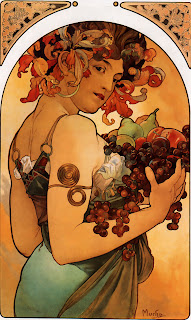Art Nouveau (1890-1914), decorative-art movement centered in Western Europe. It began in the 1880s as a reaction against the historical emphasis of mid-19th-century art, but did not survive World War I. Art nouveau originated in London and was variously called Jugendstil in Germany, Sezessionstil in Austria, and Modernismo in Spain. In general it was most successfully practiced in the decorative arts: furniture, jewelry, and book design and illustration. The style was richly ornamental and asymmetrical, characterized by a whiplash linearity reminiscent of twining plant tendrils. Its exponents chose themes fraught with symbolism, frequently of an erotic nature. They imbued their designs with dreamlike and exotic forms. The movement took its name from La Maison de l'Art Nouveau in Paris, a shop keen to promote modern ideas in art. It was influenced by the Symbolists most obviously in their shared preference for exotic detail, as well as by Celtic and Japanese art. Art Nouveau flourished in Britain with its progressive Arts and Crafts movement, but was highly successful all around the world. Art Nouveau was in many ways a response to the Industrial Revolution. Some artists welcomed technological progress and embraced the aesthetic possibilities of new materials such as cast iron. Others deplored the shoddiness of mass-produced machine-made goods and aimed to elevate the decorative arts to the level of fine art by applying the highest standards of craftsmanship and design to everyday objects. Art Nouveau designers also believed that all the arts should work in harmony to create a total work of art, or Gesamtkunstwerk: buildings, furniture, textiles, clothes, and jewelry all conformed to the principles of Art Nouveau.
| Alphonse Maria Mucha - Fruit |
http://www.allpaintings.org/v/Art+Nouveau/
Art Nouveau (1890-1914)


_-_The_Bohemian_(1890).jpg)




_-_Return_of_Spring_(1886).jpg)



_-_Lost_Pleiad_(1884).jpg)
_-_Seated_Nude_(1884).jpg)
_-_Biblis_(1884).jpg)
_-_Les_Deux_Baigneuses_(1884).jpg)
_-_The_Youth_of_Bacchus_(1884).jpg)

_-_La_Nuit_(1883).jpg)
_-_The_Nut_Gatherers_(1882).jpg)

_-_Day_(1881).jpg)
_-_Dawn_(1881).jpg)

